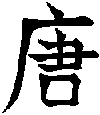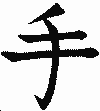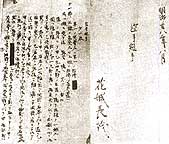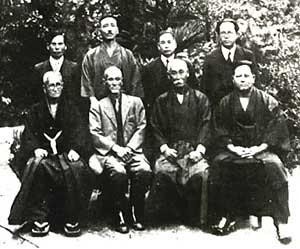What's In A Name?
How the meaning of the term karate has changed
By Maurey Levitz
Toude Before Karate
Many people are aware that karate was formerly known as "toude"
(often written "tode"), but this information seems to have remained
unknown to the general practicing population, and misunderstood by others.

Character 1
|

Character 2
|

Character 3
|
At the root of this misunderstanding lies three essential kanji (Chinese
characters). The first is pronounced "Tang" in Chinese-Mandarin
(Character 1), and refers specifically to the Tang Dynasty, one of China's
great historical eras. In Japanese, it is pronounced either "tou"
or "kara," and came to mean China in general, and things of
Chinese origin.
The second kanji is pronounced "kong" in Mandarin (Character
2), and is usually also pronounced "kara" in Japanese, but it
can also be pronounced "aki," "ku," and "sora."
The pronunciation changes according to context and grammar, and can mean
"empty," in a philosophical sense, or "sky." This
kanji does not mean "China."
The third character is pronounced "shou" in Mandarin (Character
3), and may be pronounced as either "te" or "de" in
Japanese, depending on the context, and means "hand." An alternate
pronunciation is also "shu."
In Japanese, "toude" (characters 1 and 3) means "China
hand" and not "empty hand." When Japanese say "karate,"
it could be interpreted as either "empty hand" or "China
hand." However, the average modern-day Japanese person would not
even think of translating it as "China hand."
From "Chinese Hand" To "Empty Hand"
The shift from using character 1 to character 2 (both meaning "Kara")
in karate was the result of the Okinawans taking advantage of a homonym
(two words with different definitions but identical pronunciation).
You can pronounce characters 1 and 3 as either "toude" or "karate."
But if you choose the pronunciation "karate," then it is conceivable
to use characters 2 and 3 when writing the word. Since the martial art
we are referring to is performed without weapons, the homonym "empty
hand" makes sense in this context.
 When
was this formal change in meaning and kanji made? The earliest known document
is Chomo Hanashiro's "Karate Kumite," first published in August
1905 (available in the 1992 reprint of Genwa Nakasone's 1938 "Karate-Do
Taikan," in Japanese). Hanashiro was a greatly respected karate master.
He was a student of Bushi Matsumura and later Itosu. Along with Itosu
he helped introduce karate into the Okinawan school system. When
was this formal change in meaning and kanji made? The earliest known document
is Chomo Hanashiro's "Karate Kumite," first published in August
1905 (available in the 1992 reprint of Genwa Nakasone's 1938 "Karate-Do
Taikan," in Japanese). Hanashiro was a greatly respected karate master.
He was a student of Bushi Matsumura and later Itosu. Along with Itosu
he helped introduce karate into the Okinawan school system.
Nakasone's book clearly shows Hanashiro's use of characters 2 and 3 in
the title of his book. Although the "empty hand" characters
had been used, "China hand" remained the more popular written
expression of the martial art. Ankoh Itosu's (the most famous karate teacher
of his ear) "Ten Precepts of Bu," written in 1908, for example,
still used the "China hand" characters. (1)
It was a report to government on this art and it discussed the virtues
of karate including its physical education benefits for the military --
something that would appeal to authorities at a time of growing nationalism.
Many people incorrectly credit Gichin Funakoshi (considered by many as
the father of Japanese karate since he first officially demonstrated the
art in Japan and was one of the first who began teaching karate there)
as the first to write "karate" using characters 2 and 3. However,
in 1922, his first book, "Ryukyu Kenpo Tode" used the characters
1 and 3 (Chinese hand). There is also evidence that the first black belt
certificates Funakoshi gave out in 1924 used the "toude" characters
as well.
Funakoshi was clearly not the first to use the "empty hand"
(kanji) meaning for karate. He was, however, influential in popularizing
this meaning by calling on his colleagues to abandon the "Chinese
Hand" meaning of karate in favor of "empty hand."
This made sense since Japan by the 1930s had become very nationalistic.
The nation had just emerged on the international stage. Its armies had
also moved to occupy northern China (1932). Thus efforts to change karate's
meaning to "empty hand" were a measured decision, one seen necessary
to the acceptance of this newly imported art from Okinawa (If you are
fighting the Chinese in China, you might not want your children studying
something called "China hand" at school).
The well known karate historian, John Sells in his book, "Unante:
The Secrets of Karate" notes that as early as 1933 the head of the
Butokukai (the semi- official Japanese organization founded in 1895 to
preserve and promote the martial arts and ways in Japan) while visiting
Okinawa suggested the change in characters. (2)
Two years later, Funakoshi in his1935 book, "Karatedo Kyohan"
did reflect this change (empty hand).
The change from "China hand" to "empty hand" gained
immediate popularity on the main islands of Japan once it was introduced.
But back on Okinawa the change seems to have taken some Japanese mainland
influence to effect widespread Okinawan acceptance of the new name.
In 1936, Nakasone Genwa helped organize a meeting of Okinawan karate
masters.  The
meeting was sponsored by Chofu Ota, Editor-in-Chief of the Ryukyu Shinpo
Press (Okinawa's leading newspaper). The
meeting was sponsored by Chofu Ota, Editor-in-Chief of the Ryukyu Shinpo
Press (Okinawa's leading newspaper).
During the course of this meeting, an interesting discussion took place
about whether or not to accept this change in kanji, with at least some
of the masters proving hesitant. It was finally decided to adopt the new
meaning of karate so as to promote their art and its official acceptance
in Japan.
It is easy to understand the desire to change the name in the 1930's,
but what prompted Hanashiro Chomo to do so in 1905? Certainly Japan had
a long history of conflict with China -- could it have been for the same
reason?
Perhaps he felt it more accurately described the art. Some martial arts
styles had been in Okinawa for several hundred years. Maybe he felt that
the Okinawans had changed the art enough through centuries of practice
so that it really wasn't "China hand" anymore.
I would like to believe that given Okinawa's role as a historical middle
man in the region, he chose a word that, when spoken, could still lead
the dedicated martial artist back to the art's Chinese origins, while
remaining diplomatically neutral in nature. We may never really know what
motivated Hanashiro's choice of kanji.
A Note On Pronunciation
The pronunciation and Romanization of "toude" varies between
the Japanese and Okinawan (Hogen) dialects. (3)
As far as the Romanization of character 1, in modern Japanese, it can
be rendered as "tou," although you might see it written phonetically
in an English-Japanese dictionary as "tô." The Japanese
pronunciation of "tou" is similar to the English word "toe."
The Romanization of character 2 is "te," pronounced "tay"
(Some suggest that "tay" rhymes with the English word "day"
but this would add an extra sound that is not there making it sound more
like :dei." More precisely it rhymes with "pet" but without
the "t" of course).
According to Japanese rules of grammar, "te" switches to "de"
depending on usage, and "de" is pronounced like the English
word "day." The Okinawan dialect follows the same grammatical
rules as Japanese, but has different pronunciations of some words. While
pronouncing "tou" the same as the Japanese, the Okinawans pronounce
"te" like the English word "tea." When you make the
grammatical switch from "te" to "de" (as in "toude"),
the Hogen pronunciation changes to sound like the English name "Dee."
The Romanization in Hogen would therefore become "toudi." If
one wanted to use "toudi" -- although accurate -- it might be
confusing to people familiar with modern Japanese unless one specified
that the rendering was in Hogen. To promote consistency, I think we should
use the term "toude" in the growing body of historical writing
and research into our art's origins.
Not all agree with me, however. Much like movements to save dying Indian
dialects here, there are active movements to save the Okinawan dialects
(there are at least six). Thus some would say there is a lot to be said
here for preserving these terms and thus toudi should be used, but explained.
Footnotes
(1) Chomo Hanashiro and Ankoh Itosu were both
students of the famed karate teacher Sokon (Bushi) Matsumura, but later
Hanashiro also became a student of Itosu. Itosu was a teacher Gichen Funakoshi.
(2) The official name of the organization was
the Great Japan Martial Virtues Association. It was the later acceptance
of karate by this organization that paved its way for acceptance of karate
as an official Japanese martial art. In addition to the change in the
characters used to mean karate, this organization also promoted the adoption
by karate of standard uniforms, grading and teaching methods.
(3) Here the term "hogan" meaning dialect
is used to refer to the Okinwan dialect of Japanese spoken on the Island.
The discussion is actually made more complicated by the fact that there
were subtle variations in dialects of Japanese spoken on this island.
The image of Hanashiro Chomo's 1905 book is provided
by Patrick McCarthy from his book, "Karate-do Tanpenshu - Funakoshi
Gichen Short Stories", translated by Patrick and Yunko McCarthy.
About The Author:
Maurey Levitz has continually studied martial arts since 1988. He is
currently the head instructor of the New Paltz Karate Academy, an accredited
member of the American Budo Kai. He can be reached at: New Paltz Karate
Academy, PO Box 1026, New Paltz, NY 12561 (845 255-4523). His e-mail
is Deshi@idsi.net
and his website is Newpaltzkarate.com.
|